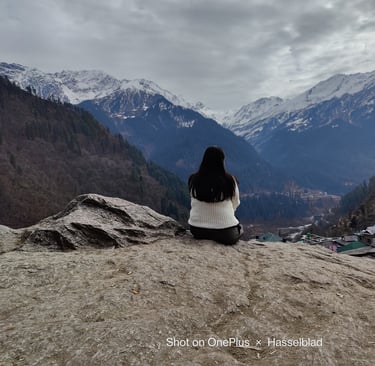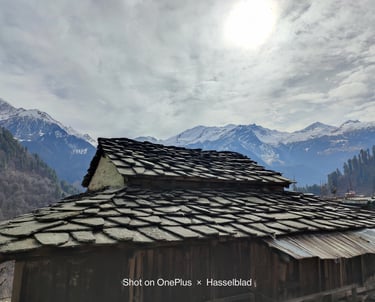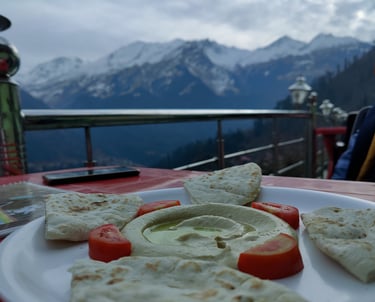Village without motorable roads
My Escape into the Heart of Parvati Valley
TRAVEL
8/25/20254 min read


Nestled deep in the Parvati Valley of Himachal Pradesh, Tosh is one of those Himalayan villages where time slows down, the air feels purer, and the mountains watch over you in silence. Perched at around 7,900 feet, Tosh offers everything I crave in a Himalayan getaway—stunning views, peace, and a slice of slow mountain life.
How I Reached Tosh
On my trip, I decided to take a direct overnight bus from Delhi to Kasol instead of breaking the journey at Bhuntar. I was lucky enough to catch a local bus from Kasol to Barshaini, which is the last motorable point in the valley. From there, I took a cab to the starting point of Tosh, as the village itself is non-motorable.
To enter Tosh, I had to cross a small debris of a landslide right at the entrance—a reminder that you’re in the raw Himalayas, where nature rules. The short walk into the village was scenic, with wooden houses, prayer flags fluttering, and snow-capped peaks forming a majestic backdrop.
I started my journey from Delhi, catching an overnight Volvo bus to Bhuntar (around 12–13 hours). From Bhuntar, I took a local bus to Kasol and then a cab to Barshaini, the last motorable village in Parvati Valley. From there, Tosh is just a 3–4 km uphill drive or an easy hike, and the views along the way are enough to make you forget the journey’s exhaustion.
If you’re already staying in Kasol or Manikaran, Tosh makes for a perfect half-day or overnight trip. I recommend starting early so you can enjoy the valley in daylight.
Stay Options in Tosh
I stayed at a wooden guesthouse overlooking the valley, and waking up to those mountain views was pure bliss. Tosh has plenty of budget homestays, guesthouses, and backpacker hostels. Many of them have balconies or terraces offering panoramic views of the Himalayas.
If you want something livelier, there are also camps and hostels popular among backpackers, where you’ll find bonfire nights and live music sessions. No matter where you stay, you’ll always have that stunning Himalayan panorama in sight.
The Magic of Tosh
The first thing I noticed about Tosh was the absolute stillness, broken only by the sound of the Parvati River gushing far below and children laughing in the narrow village lanes. The snowy peaks, beautiful but not-so-famous, dominate the horizon, making every view near-perfect.
I spent hours just wandering the narrow paths, stopping for chai, talking to locals, and watching clouds drift through the valley. Tosh is the kind of place where you feel an instant connection with the mountains.
What I Did in Tosh
Tosh is more about soaking in the vibe than chasing a checklist, but here’s how I spent my time:
Café hopping: I covered multiple cafés, including the much-hyped Pink Floyd Café, and I have to admit—it lives up to the hype. The mesmerising views of the valley from there are worth every step uphill. Sitting with a cup of tea, looking at the snow peaks—it’s an experience I’ll never forget. The cafés here offer a mix of local Himachali food, Israeli delicacies, pizzas, pastas, and endless cups of chai. I loved eating while watching clouds drift through the valley—it’s almost a ritual for travelers here.
Nature walks: Tosh is best explored on foot. Walking through apple orchards and wooden houses while greeting locals feels magical.
The bonfires in the evenings are bliss amid dipping mercury. I was lucky, again, to get a warm cozy dining space at my hotel with traditional sitting with some yummy local food.
The village doesn’t have motorable roads, so you walk everywhere, which adds to its serene charm.
Beyond Tosh – My Itinerary Highlights
After soaking in Tosh’s charm, I took a cab back to Barshaini and continued exploring the valley:
Manikaran Sahib Gurudwara: A must-visit for its hot springs and langar.
Kullu’s Naggar Castle: I visited this beautiful heritage site before boarding my Volvo bus back to Delhi from Kullu.
If time permits, you can also spend a day in Kasol, sit by the Parvati River, and just let the sound of the gushing water soothe you.
Best Time to Visit Tosh
The ideal time is March to June and September to November. I visited in April, and the weather was perfect—pleasant days and chilly evenings.
Avoid monsoon (July–August) as the region is landslide-prone, and access can become difficult. Winter (December–February) turns Tosh into a snow paradise, but be prepared for freezing temperatures.
Costs & Travel Tips from My Experience
Traveling to Tosh is quite affordable:
Direct Volvo bus from Delhi to Kasol: ₹900–₹1,500
Local bus Kasol to Barshaini: ₹100–₹150
Shared cabs Barshaini to Tosh starting point: ₹50–₹100 per person
Decent guesthouses: ₹600–₹1,200 per night; hostels can be even cheaper
Food: ₹200–₹500 per meal at cafés
Travel tips from my trip:
Carry cash; ATMs are scarce.
Pack warm layers, even in summer; nights get cold.
Be ready for short treks or walks—Tosh is non-motorable.
Respect the local culture; Tosh is a small, close-knit village.
Why Tosh Stays with Me
For me, Tosh wasn’t just about its famous cafés and Himalayan views; it was about the rawness of the mountains. Crossing a landslide patch, sipping tea at Pink Floyd while watching clouds float by, visiting the temple, and ending the trip with Manikaran Sahib and Kullu’s castle—it all felt like a perfect Himalayan story.
If you’re heading to Kasol or Parvati Valley, don’t miss Tosh. It’s a small detour that leaves a big impact on your heart.






